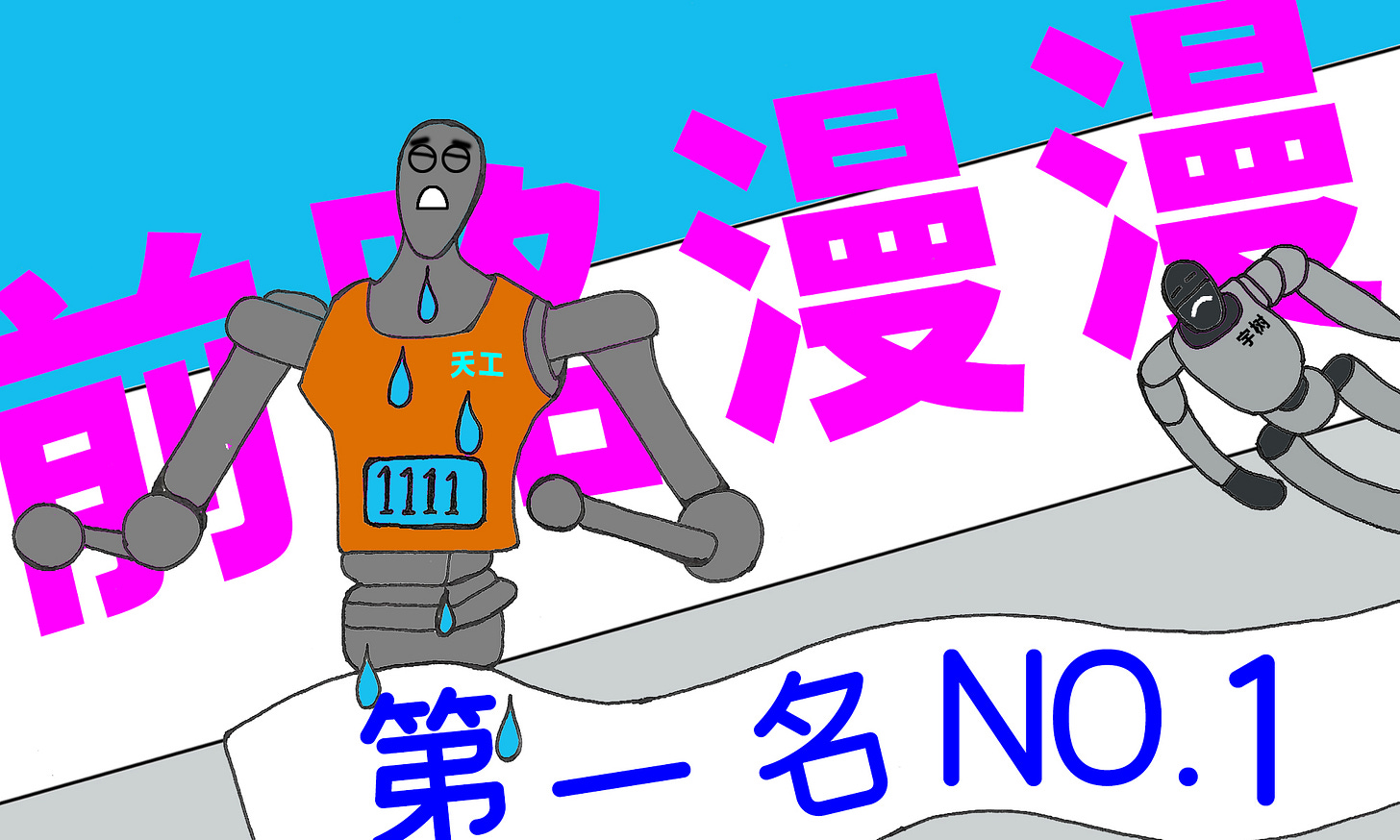Welcome to RealTime Mandarin, a free weekly newsletter that helps you improve your Mandarin in 10 minutes a week.
Subscribe today to get your fluency back, stay informed about China, and communicate with confidence in Chinese — all through immersion in real news.
On April 19, the world's first human-robot half-marathon took place in Beijing, with 20 humanoid robots competing against 12,000 humans.
In Chinese, "humanoid robot" is "human-shaped robot" (人形机器人).
The 21.1 km course challenged robotic runners with uneven road conditions, speed bumps, gravel and cambered surfaces, tight turns, and steep inclines.
Entrants included the Tiangong Ultra (天工Ultra), the Unitree G1 (宇树G1), as well as other machines developed by lesser-known grassroots teams like Songyan Power (松延动力), and Taihu Robots (钛虎机器人).
Unitree (宇树机器人), a start-up from Hangzhou backed by e-commerce giant, Meituan, shot to fame in February this year, following a performance by its dancing robots during the state-sponsored Spring Festival Gala.
But in the “Beijing Half (北京半马)”—an unscripted, messy, real-world event—the G1 model didn’t fare so well.
Seconds after an over-confident wave to the cameras, it stumbled and collapsed just past the starting line and then decided to “lie flat” (躺平).
The poor showing drew criticism online, prompting Unitree to issue an explanation:
“Robot performance can vary significantly depending on who is operating or developing it. Please take this into consideration.” [2]
“不同人操作或开发情况下,机器人的表现差别很大,请大家不要误解。”
Background: It’s hardware was used by a number of external teams who integrated their own software into the G1 for the race.
The G1 wasn’t the only one not to complete the race—only six made it to the finish line.
The winner, the Tiangong UItra, made it in 2 hours, 42 minutes.
Tiangong was developed by the Beijing Humanoid Robot Innovation Center, a joint venture established in 2023 by the Beijing government and a number of tech companies including Xiaomi Robotics—part of Xiaomi 小米, a company better known for its slick EV cars, and fancy mobile phone handsets.
From the RTM archive: more on Xiaomi
During the race teams of engineers jogged alongside the robots, busy adjusting algorithms, swapping out batteries, and helping to avoid obstacles.
But for the humans involved, this wasn't about speed, or winning.
It was about finishing.
This was an opportunity to test how robots handle sustained movement under extreme conditions which can’t be replicated in a lab.
Xiong Youjun (熊友军), the CEO of the winning team, explains:
“This isn’t just a simple sports competition—it’s a true test of technological breakthroughs and the future of the industry.
Even though we still have a long way to go before humanoid robots are commercialized, the future of such robots is no longer science fiction, as the industry inches closer to key technical breakthroughs.”
“这不只是简单的体育竞技,更是对技术突破、产业发展的‘极限测试’。尽管,目前关于人形机器人的商业化问题依然前路漫漫,但随着技术临界点的日益临近,人形机器人的曙光正在到来。”
He and others reckon humanoid robots are unlikely to be part of our lives any time soon.
China’s supply chain is still underdeveloped, and much of the kit needed hasn’t been invented yet, which means there are still many challenges like overheating, high energy consumption, and poor stability.
"It will probably take around another 10 years before they can truly become part of our daily life."
“真正走到我们身边,我认为大概还需要10年左右。” [2]
After the race, the participating teams joined the "Future Trends of Humanoid Robots" forum, sharing their experiences and discussing future applications.
What drew most attention in those discussions were the “car crash” moments (翻车事件)—the failures during the race, but with an eye on the future, as one engineers puts it:
If we look back at this event in five or ten years’ time, it will be seen as a milestone in the history of humanoid robot development.
Those moments of failure will be valuable fuel for the growth of robots—ultimately accelerating the arrival of the future. [6]
如果在五年后、十年后回看这场比赛,它将成为人形机器人发展史上一个别具意义的里程碑事件,那些「翻车瞬间」都成为了机器人成长的养分,最终加速了未来的到来。 [6]
What do you think? Is he right?
What is for sure is that future advances in robotics seem more likely to happen in China than anywhere else.
Which is what we’re exploring this week!
🎧RTM Podcast Preview
This week on the RTM Advanced podcast, we’re diving into the language of how to discuss how it’s still early days for humanoid robotics in China.
How do native speakers express that there’s still a long way to go?
“A long road ahead” — 前路漫漫 qián lù màn màn (Listen at 9:54)
“[Only] the first half” — 上半场 shàng bàn chǎng (Listen at 11:38)
“Too early to tell” — 为时尚早 wéi shí shàng zǎo (Listen at 13:09)
We’ll unpack each phrase, show you how they’re used in real contexts, and help you sound more natural and precise in your own Chinese.
Favourite Five
1. 怯场 qiè chǎng
stage fright, freeze up
上过春晚的「大网红」宇树机器人在起跑前自信挥手,结果一出发就「怯场」不愿前行 - The internet-famous Unitree robot, who appeared on the Spring Festival Gala, confidently waved to the crowd before the start—but froze up and refused to move once the race began. [6]
2. 出洋相 chū yáng xiàng
make a fool of oneself, embarrass oneself
这些在大众眼中“出洋相”的机器人,并非是它们的黑历史,而是人形机器人都要走完的必经之路 - Those embassing moments do not mark the failure of humanroid robots – they constitute an essential phase in their development. [3]
3. 前路漫漫 qián lù màn màn
a long road ahead, a long way to go
尽管,目前关于人形机器人的商业化问题依然前路漫漫,但随着技术临界点的日益临近,人形机器人的曙光正在到来 - Even though we still have a long way to go before humanoid robots are commercialized, the future of such robots is no longer science fiction, as the industry inches closer to key technical breakthroughs. [3]
More: learn more about the origins of this 2,000 year old idiom in tomorrow's Sinica Phrase of the Week.
4. 为时尚早 wéi shí shàng zǎo
premature, too early
大家担心机器人“抢饭碗”,其实为时尚早 - It is actually too early for people to worry about robots taking their jobs. [5]
5. 好事多磨 hǎo shì duō mó
good things take time, the road to success is bumpy
主办方笑谈,“上周的风,昨日的雨,没有风雨,不见彩虹”,以此形容赛程好事多磨 - The organiser joked, “Strong wind last week, heavy rain yesterday—but without storms, there’s no rainbow.” Good things take time! [1]
💡 Ready to bridge the gap to real-world fluency? 💡
Every RTM+ post is packed with tools to help you get fluent.
Whether you’re “intermediate”, “advanced but rusty”, or “fluent with gaps”, you’ll get content that’s practical, engaging, and easy to stick with, even if you “have no time” or “aren’t at the right level yet”.
Those are excuses. And this is the solution!
Take action, build momentum, and finally break through your plateau towards real-world fluency. 👇

















